|
My visit to Quebec was not a fishing trip. Well, at least
it was not primarily a fishing trip. I went with my wife
Joan to travel through the Saguenay area and secondarily
to meet Chris Chin and spend a day fishing with him. The
Saguenay is the water body fed by the Ste. Marguerite river
as well as others. The Saguenay feeds into the St. Lawrence
and from the St. Lawrence come the Salmon and sea run Brookies
which travel up into the Ste. Marguerite. I also thought of
this as a pre-fish-in as I stayed at the 5 star farm (ferme
cinq etoile), fished where those coming up in August will
fish and was guided by our own Chris Chin. If there is a
pre-fish-in acceptability test this passed.
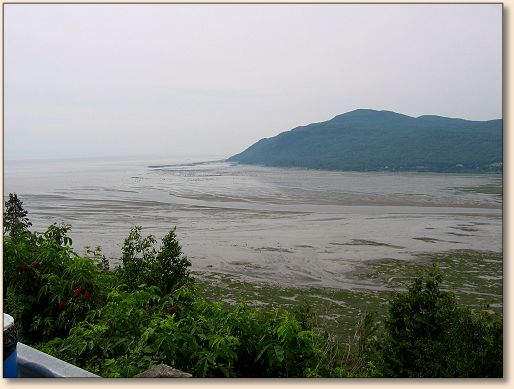
My trip was magnificent. Joan, a non-fisher who loves the
outdoors, also had a great time. The Saguenay's north shore
is a place that before the mid thirties was undeveloped.
You travel about 60 miles from the mouth of the Saguenay
and you'll see only two small towns. No Wall Marts or Malls.
No big grocery stores or tourist shops. It's quiet up there.
The Saguenay itself is a Fjord. It was cut by the glaciers
and the cliffs are hundreds of feet high and the water is
over 900 feet deep. It is about 38 to 40 degrees cold. The
top layer is fresh water coming from an immense watershed.
The bottom two layers are salt water fed as a tidal estuary.
Salt water comes in on the bottom with the tides and an
upwelling puts it into the middle layer. In the Saguenay
there are both fresh and salt water fish. At the point where
the Ste. Marguerite empties into the Saguenay and again where
the Saguenay enters into the St. Lawrence there are families
of Beluga whales that can be seen from shore. On the St.
Lawrence, which is the largest salt-water estuary in the world
you can see Minkie, Blue and Finback whales. There is also a
population of Beluga whales which almost exclusively live above
the 50th parallel, but due to the cold water temperatures exists
at the mouth of the Saguenay. Salmon cruise these waters and
they are now re-introducing the Striped Bass whose populations
were decimated by pollution and the destruction of the marshlands
that provided the Striped Bass feeding zones. In all it is a
truly unique and beautiful environment that is open.
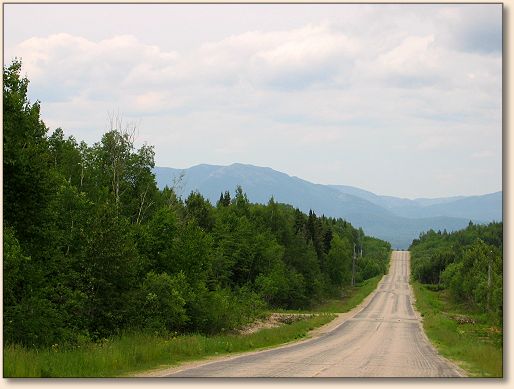
While the geology of this area is a little unclear to me it
seems that the Laurentian mountains and the St. Lawrence River
were created by tectonism, the splitting of the earths crust
and the dropping of the land which created the St. Lawrence
lowlands including the St. Lawrence river.
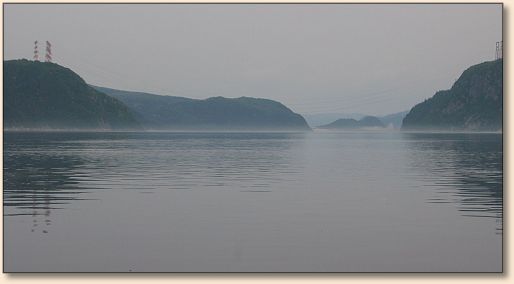
The Saguenay River is a gash in the Precambrian rock and
the Fjord was created at the mouth of the river by the
recent (in geological terms) spate of Pleistocene glaciation,
consisting of repeated invasions of massive continental
glaciers from the north. Finally the "isostatic adjustment"
or the earth rebounding after the lifting of the weight of
over a 1 ½ mile thick sheet of ice changed the final makeup
of the area to bring it to a form we now recognize.
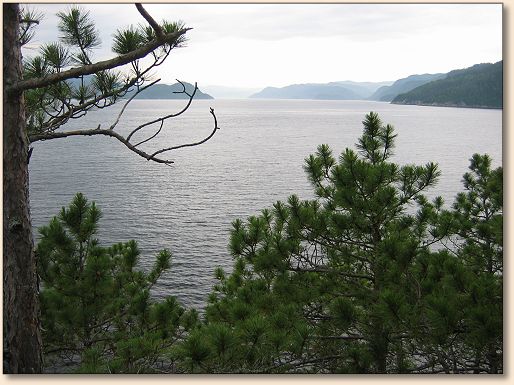
Because the Seaway runs North and is separated from the
Atlantic Ocean which is to its east it does not get any
warming effect from the Gulf Stream. All its waters comes
from the Gulf of St. Lawrence and the North Atlantic. This
geological formation is what creates the unique environment
we visited.
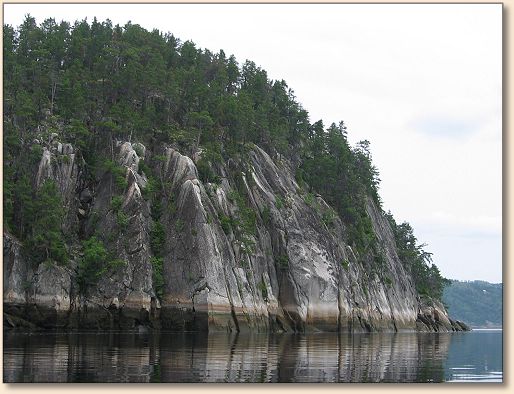
There are two watersheds that feed the Saguenay River. The
Saguenay watershed and the Lake Saint Jean watershed comprising
88,000 square kms. of area or an area 200 miles by 200 miles.
One of the main rivers feeding this is the St. Marguerite River.
Where the St. Marguerite empties into the Saguenay there is a
permanent school of Beluga whales. By taking a 3 km. walk on
a level path you can find yourself at the tip of a peninsula
where you can sit on benches provided by the province and watch
the Beluga. The St. Marguerite is not a food rich river so
there is not a lot of holdover trout but it has wonderful
spawning beds shared by the salmon and sea run trout. In late
June we see the first arrivals of salmon followed by the coming
of the trout. Salmon fishing starts on June 1st and closes on
September 15th. It then closes for spawning. Sea trout can be
fished until October 15th. Along the 60 plus miles of river
there are about 100 marked pools or runs that may hold fish.
The river is completely controlled and patrolled by the ZEC
(zone of exploitation control). It is divided into zones which
each contain a number of areas. Each zone is determined to be
either limited or unlimited rods and is priced accordingly.
To fish you need your provincial license and a permit to fish
a particular zone.
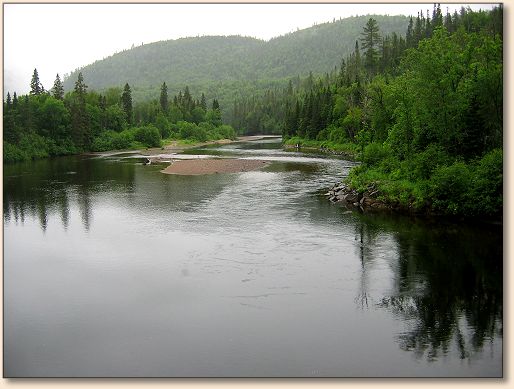
When I met Chris on the morning we planned to go fishing I
was as excited as a schoolboy on his first day of school.

I had planned for this day and had my rod and reel selected,
flies leaders and all the miscellanea that one needs to enjoy
fishing. I even remembered some bug dope and sun screen. Our
first stop was to the ZEC office where we signed up for the day
and paid. As we were early we paid through a slot in the wall.
I did not have change, but Chris said not to worry. We could
return and get the change later. We discussed the different
pools and possibilities, and being smart I left any and all
decision making in Chris' hands. He choose (Zone 3) and we
fished. The river was up and the water was not clear. This
made sight fishing impractical. I fished the currents based
on Chris' instructions believing that the fish were there.
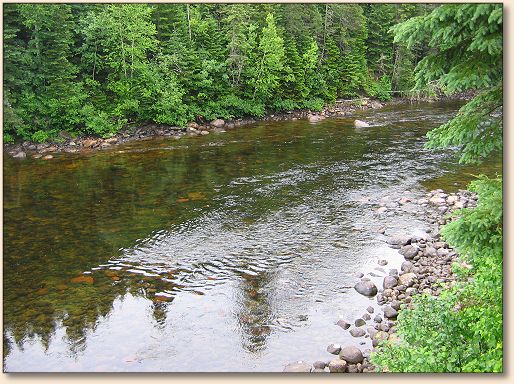
During the day we went to several pools and tried our luck.
In the end we did not catch any fish but we did have a grand
time together including a lunch cooked up by Chris. Joan joined
up for lunch and we took the time to pepper Chris with all the
questions we had stored up during the previous days of travel.
Most questions he answered accurately and some a little less so.
He told us that the forest on the other side of the river is
virgin forest for as far as the eye can see. Where I live I
have to drive an hour and hike for two to see virgin timber.
His was able to identify all the birds we had asked about.
"There are big birds that eat little birds, little brown birds
and birds that eat fish". When we asked him to help with the
ID of a yellow winged bird his reply was "that's a little
brown bird...that's yellow". I cannot thank Chris enough
for inspiring me to take this trip north. We parted ways at
the end of a very successful fishing adventure. The day had
everything except fish and that's not so bad.
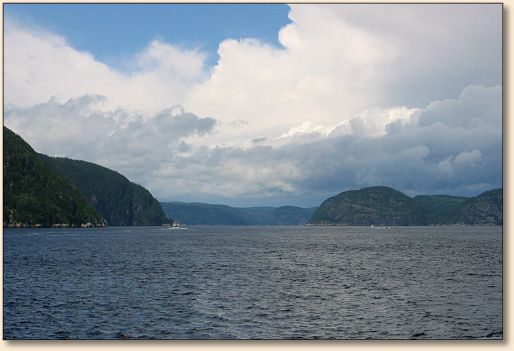
Last night as I regaled my friends about our adventure up
north I described the Saguenay as being a place that is near
the edge of human dominance. It is that place where you can
see into the distance and know that what is before you is
wild and what is behind you is not. It is a place where you
can find everything you need, but not everything you may want.
It is a place where life is hard enough that those who live
there depend on each other and calm enough that people are
warm and friendly. We now have another couple that we are
talking about taking a return trip there with. He also fishes
and she loves hiking and the natural world. You can bet that
we will book a few more days on the river this time. ~ Jed Proujansky
|









